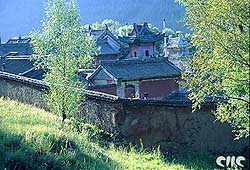Buddhist Mount Wutai listed World Heritage
China Daily, Sept 24, 2012
Mt. Wutai, China -- China's Mount Wutai became China's 38th site to join UNESCO's World Heritage List as a cultural landscape.
 "We've been through a rough path, full of suspense," Tong Mingkang, deputy chief of China's State Administration of Cultural Heritage, said after the announcement.
"We've been through a rough path, full of suspense," Tong Mingkang, deputy chief of China's State Administration of Cultural Heritage, said after the announcement.
Mount Wutai, literally the five-terrace mountain, is a sacred Buddhist mountain with five flat peaks. The cultural landscape features 53 monasteries and includes the East Main Hall of Foguang Temple, a structure that was built in 857 during the Tang Dynasty (618-917) and is one of the oldest wooden buildings in China.
It also features the Ming Dynasty (1368-1644) Shuxiang Temple with a huge complex of 500 statues representing Buddhist stories woven into three dimensional pictures of mountains and water.
Mount Wutai, located in Shanxi Province, is the highest mountain in northern China and is remarkable for its morphology characterized by precipitous sides with five open treeless peaks. Temples were built on the site from the first century AD to the early 20th century.
The 33rd Session of the World Heritage Committee, chaired by Maria Jesus San Segundo, the ambassador and permanent delegate of Spain to UNESCO, was expected to add additional sites to its list from the 37 nominations later Friday and Saturday.
Read More @ Source
Comments
Post a Comment